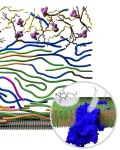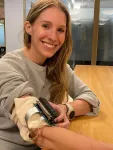(Press-News.org)
The first-ever archeological survey in space has provided new insights into how astronauts use and adapt their living space on the International Space Station, which could influence the design of new space stations after the ISS is decommissioned.
Findings from the research team behind the International Space Station Archaeological Project (ISSAP) were published today in the journal PLOS ONE. Archaeologist Justin Walsh of Chapman University is available to discuss the discoveries of the team’s first on-orbit project, the Sampling Quadrangle Assemblages Research Experiment (SQuARE).
While Earth-bound archaeologists dig one-meter squares to understand a site and strategize further study, the ISSAP team had the astronauts use adhesive tape to define one-meter areas of the International Space Station and document them with daily photographs to study how the spaces were used over 60 days in 2022. The squares were placed in a handful of work and leisure locations on the space station, including the U.S. galley table, workstations, experimental EXPRESS racks and on the wall across from the latrine where astronauts kept their toiletries.
The team’s findings provide the first glimpse into how astronauts adapt to life and conduct research without gravity, how international cooperation plays out in the tight quarters, how they use their space for work and leisure while in orbit, and more. By cross-referencing the photos with astronaut activity reports, the researchers found that the area near the exercise equipment and latrine, while not designated for any particular purpose, had been used as storage for toiletries, resealable bags, and a rarely used computer. The equipment maintenance area was actually used for storage, with little maintenance carried out there.
Beyond informing the future of space habitats, these findings demonstrate how traditional archaeological techniques can be adapted to study extreme and remote habitats, such as Antarctic research stations or the peak of Mt. Everest. ISSAP’s innovative work on SQuARE won awards from the Archaeological Institute of America and the American Anthropological Association in 2023, and the team’s two co-PIs were both named to the Explorers Club 50 Class of 2024.
“Archaeology is not just about the very distant past,” said Walsh, who is also a co-founder of Brick Moon, a consultancy in space habitat design and use. “It’s about using objects, artifacts, built spaces and architecture as primary evidence for how humans behave, interpret and adapt to the world around them. Archaeology has a place in space.”
END
Newly published report outlines findings from first archaeology project in space
2024-08-07
ELSE PRESS RELEASES FROM THIS DATE:
Memory loss in aging and dementia: Dendritic spine head diameter predicts memory in old age
2024-08-07
BIRMINGHAM, Ala. – Over the course of life, memory fades with varying degrees, robbing older people of the ability to recollect personal experiences. This progressive, nearly inevitable process has long been hypothesized as a consequence of nature’s removal of dendritic spines, a key component of synapses, from brain neurons as they age.
A study published in Science Advances led by researchers at the University of Alabama at Birmingham and Rush University Medical Center, Chicago, Illinois, now provides evidence that the preservation of past life experiences ...
Birmingham host to investigational treatment trial which could improve outcomes of pregnancies affected by severe haemolytic disease
2024-08-07
Pregnant mothers have taken part in a clinical study (the UNITY trial) in Birmingham, which has found that nipocalimab, an investigational, fully human, monoclonal antibody, has the potential to improve the survival rate of unborn babies with rare, early-onset fetal anaemia, as a result of haemolytic disease of the fetus and newborn (EOS-HDFN).
The study investigated pregnancies complicated by severe EOS-HDFN (RhD (D) or Kell (K) alloimmunized pregnant individuals with singleton pregnancies) and evaluated the effects of nipocalimab at weekly intervals from 14-35 ...
Drug trial for rare fetal blood disease shows promise for less invasive approach
2024-08-07
AUSTIN, Texas — Data from a new investigational drug that could alter the standard treatment for a rare blood disease suggests it has the potential to delay or prevent anemia and the need for intrauterine blood transfusions in babies who are at high risk for the condition, known as Hemolytic Disease of the Fetus and Newborn (HDFN). Results of the Phase 2 clinical trial of the drug nipocalimab were published today in The New England Journal of Medicine.
HDFN is a serious condition in which the blood types of the mother and her fetus do not match, potentially causing life-threatening anemia in the baby. The current ...
Forever chemical pollution can now be tracked
2024-08-07
Organofluorine compounds — sometimes called ‘forever chemicals’ — are increasingly turning up in our drinking water, oceans and even human blood, posing a potential threat to the environment and human health.
Now, researchers at The University of Texas at Austin have developed a way to fingerprint them, which could help authorities trace them to their source when they end up in aquifers, waterways or soil.
The technique involves passing samples through a strong magnetic field then reading the burst of radio waves their atoms emit. This reveals ...
How fungi elude antifungal treatments
2024-08-07
Every year, life-threating invasive fungal infections afflict more than 2 million individuals globally. Mortality rates for these infections are high, even when patients receive treatment.
Aspergillus fumigatus, the most frequent cause of invasive fungal infection in people with suppressed immune systems, is responsible for approximately 100,000 deaths annually around the world. Poor treatment outcomes result from therapeutic failures and the fungi’s resistance to existing drugs.
A new multi-institutional study led by researchers at Michigan State University has characterized how fungi adapt to restructure their cell walls, effectively ...
ACC Asia 2024 explores emerging trends, evidence-based strategies for improving global heart health
2024-08-07
The American College of Cardiology (ACC) and the Cardiological Society of India will host ACC Asia 2024 on August 16-18 in Delhi, India. This conference will bring together all members of the cardiac care team to examine emerging trends and best practices for cardiovascular disease patient care.
“One of the most meaningful outcomes of the annual ACC Asia conference is the ability to communicate with other cardiologists to strategize and innovate new ideas,” said Eugene Yang, MD, MS, FACC, one of the ACC Asia conference co-chairs. “As ...
CalTech team develops first noninvasive method to continually measure true blood pressure
2024-08-07
Solving a decades-old problem, a multidisciplinary team of Caltech researchers has figured out a method to noninvasively and continually measure blood pressure anywhere on the body with next to no disruption to the patient. A device based on the new technique holds the promise to enable better vital-sign monitoring at home, in hospitals, and possibly even in remote locations where resources are limited.
The new patented technique, called resonance sonomanometry, uses sound waves to gently stimulate resonance ...
Using photos or videos, these AI systems can conjure simulations that train robots to function in physical spaces
2024-08-07
Researchers working on large artificial intelligence models like ChatGPT have vast swaths of internet text, photos and videos to train systems. But roboticists training physical machines face barriers: Robot data is expensive, and because there aren’t fleets of robots roaming the world at large, there simply isn’t enough data easily available to make them perform well in dynamic environments, such as people’s homes.
Some researchers have turned to simulations to train robots. Yet even that process, which often involves a graphic designer ...
When is too much knowledge a bad thing?
2024-08-07
CORNELL UNIVERSITY MEDIA RELATIONS OFFICE
FOR RELEASE: August 7, 2024
Kaitlyn Serrao
607-882-1140
kms465@cornell.edu
When is too much knowledge a bad thing?
ITHACA, N.Y. – A new study finds an increase in knowledge could be a bad thing when people use it to act in their own self-interest rather than in the best interests of the larger group.
Cornell University economics professor Kaushik Basu and Jörgen Weibull, professor emeritus at the Stockholm School of Economics, are co-authors ...
Do smells prime our gut to fight off infection?
2024-08-07
Many organisms react to the smell of deadly pathogens by reflexively avoiding them. But a recent study from the University of California, Berkeley, shows that the nematode C. elegans also reacts to the odor of pathogenic bacteria by preparing its intestinal cells to withstand a potential onslaught.
As with humans, nematodes’ guts are a common target of disease-causing bacteria. The nematode reacts by destroying iron-containing organelles called mitochondria, which produce a cell's energy, to protect this critical element from iron-stealing bacteria. Iron is a key catalyst in many enzymatic reactions in cells — in particular, ...




